Impact of Performance Appraisal on Employee Compensation Report
VerifiedAdded on 2019/09/30
|8
|1682
|60
Report
AI Summary
This report delves into the critical aspects of Human Resource Management, specifically focusing on performance appraisal methods and their influence on employee compensation. It begins by outlining various performance appraisal techniques, such as the paired comparison and 360-degree feedback methods, emphasizing their role in evaluating employee performance and aligning it with remuneration. The report then explores the connection between performance appraisal and employee compensation, acknowledging that an effective compensation plan is crucial for employee motivation and organizational performance. Furthermore, it analyzes the impact of performance appraisal on different stakeholders within an organization. Finally, the report provides recommendations for preventing ethical and legal challenges that can arise when aligning performance appraisal and compensation, ensuring fairness and compliance. The report draws on several academic sources to support its arguments and provide a comprehensive understanding of the topic.
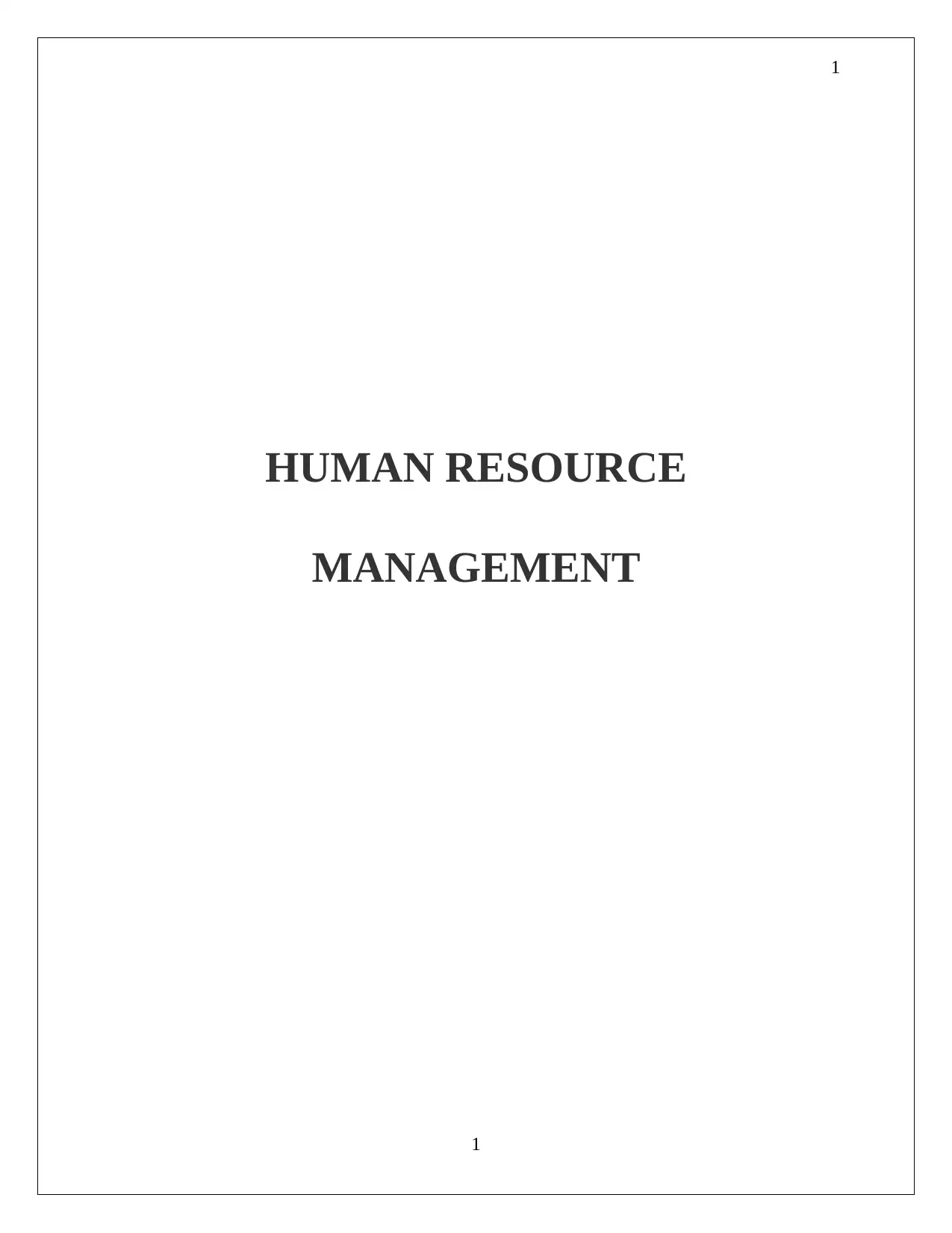
1
HUMAN RESOURCE
MANAGEMENT
1
HUMAN RESOURCE
MANAGEMENT
1
Paraphrase This Document
Need a fresh take? Get an instant paraphrase of this document with our AI Paraphraser
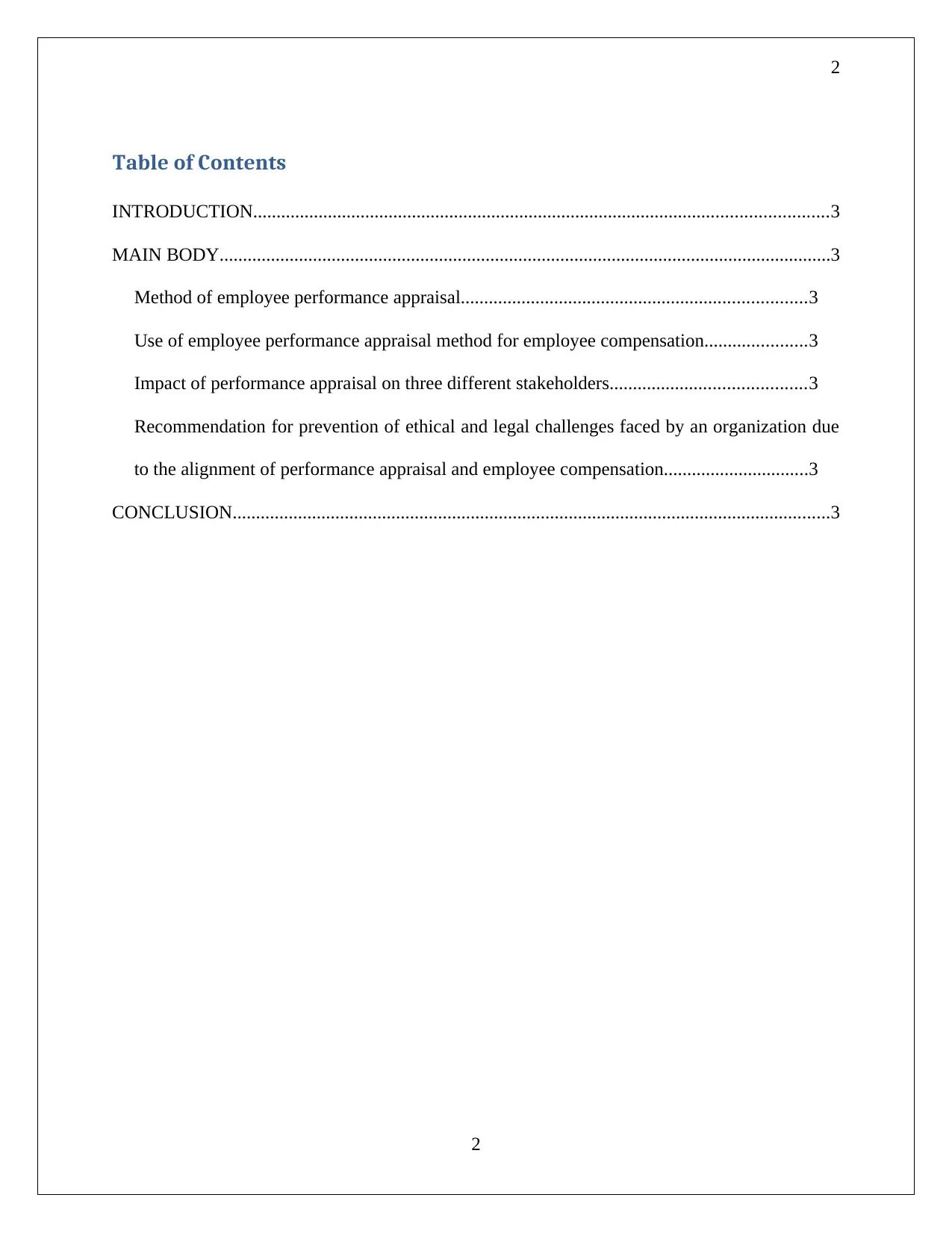
2
Table of Contents
INTRODUCTION...........................................................................................................................3
MAIN BODY...................................................................................................................................3
Method of employee performance appraisal..........................................................................3
Use of employee performance appraisal method for employee compensation......................3
Impact of performance appraisal on three different stakeholders..........................................3
Recommendation for prevention of ethical and legal challenges faced by an organization due
to the alignment of performance appraisal and employee compensation...............................3
CONCLUSION................................................................................................................................3
2
Table of Contents
INTRODUCTION...........................................................................................................................3
MAIN BODY...................................................................................................................................3
Method of employee performance appraisal..........................................................................3
Use of employee performance appraisal method for employee compensation......................3
Impact of performance appraisal on three different stakeholders..........................................3
Recommendation for prevention of ethical and legal challenges faced by an organization due
to the alignment of performance appraisal and employee compensation...............................3
CONCLUSION................................................................................................................................3
2
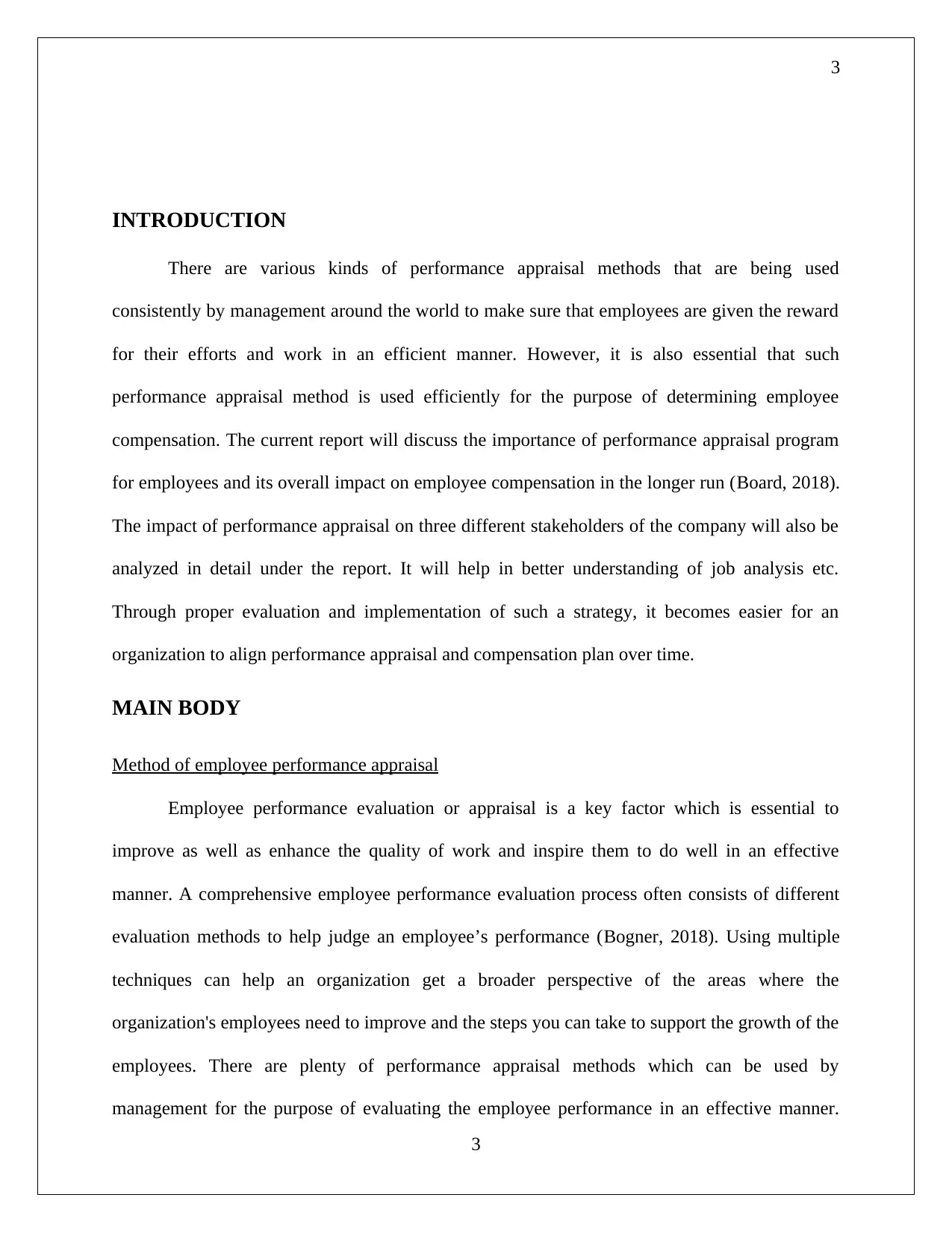
3
INTRODUCTION
There are various kinds of performance appraisal methods that are being used
consistently by management around the world to make sure that employees are given the reward
for their efforts and work in an efficient manner. However, it is also essential that such
performance appraisal method is used efficiently for the purpose of determining employee
compensation. The current report will discuss the importance of performance appraisal program
for employees and its overall impact on employee compensation in the longer run (Board, 2018).
The impact of performance appraisal on three different stakeholders of the company will also be
analyzed in detail under the report. It will help in better understanding of job analysis etc.
Through proper evaluation and implementation of such a strategy, it becomes easier for an
organization to align performance appraisal and compensation plan over time.
MAIN BODY
Method of employee performance appraisal
Employee performance evaluation or appraisal is a key factor which is essential to
improve as well as enhance the quality of work and inspire them to do well in an effective
manner. A comprehensive employee performance evaluation process often consists of different
evaluation methods to help judge an employee’s performance (Bogner, 2018). Using multiple
techniques can help an organization get a broader perspective of the areas where the
organization's employees need to improve and the steps you can take to support the growth of the
employees. There are plenty of performance appraisal methods which can be used by
management for the purpose of evaluating the employee performance in an effective manner.
3
INTRODUCTION
There are various kinds of performance appraisal methods that are being used
consistently by management around the world to make sure that employees are given the reward
for their efforts and work in an efficient manner. However, it is also essential that such
performance appraisal method is used efficiently for the purpose of determining employee
compensation. The current report will discuss the importance of performance appraisal program
for employees and its overall impact on employee compensation in the longer run (Board, 2018).
The impact of performance appraisal on three different stakeholders of the company will also be
analyzed in detail under the report. It will help in better understanding of job analysis etc.
Through proper evaluation and implementation of such a strategy, it becomes easier for an
organization to align performance appraisal and compensation plan over time.
MAIN BODY
Method of employee performance appraisal
Employee performance evaluation or appraisal is a key factor which is essential to
improve as well as enhance the quality of work and inspire them to do well in an effective
manner. A comprehensive employee performance evaluation process often consists of different
evaluation methods to help judge an employee’s performance (Bogner, 2018). Using multiple
techniques can help an organization get a broader perspective of the areas where the
organization's employees need to improve and the steps you can take to support the growth of the
employees. There are plenty of performance appraisal methods which can be used by
management for the purpose of evaluating the employee performance in an effective manner.
3
⊘ This is a preview!⊘
Do you want full access?
Subscribe today to unlock all pages.

Trusted by 1+ million students worldwide
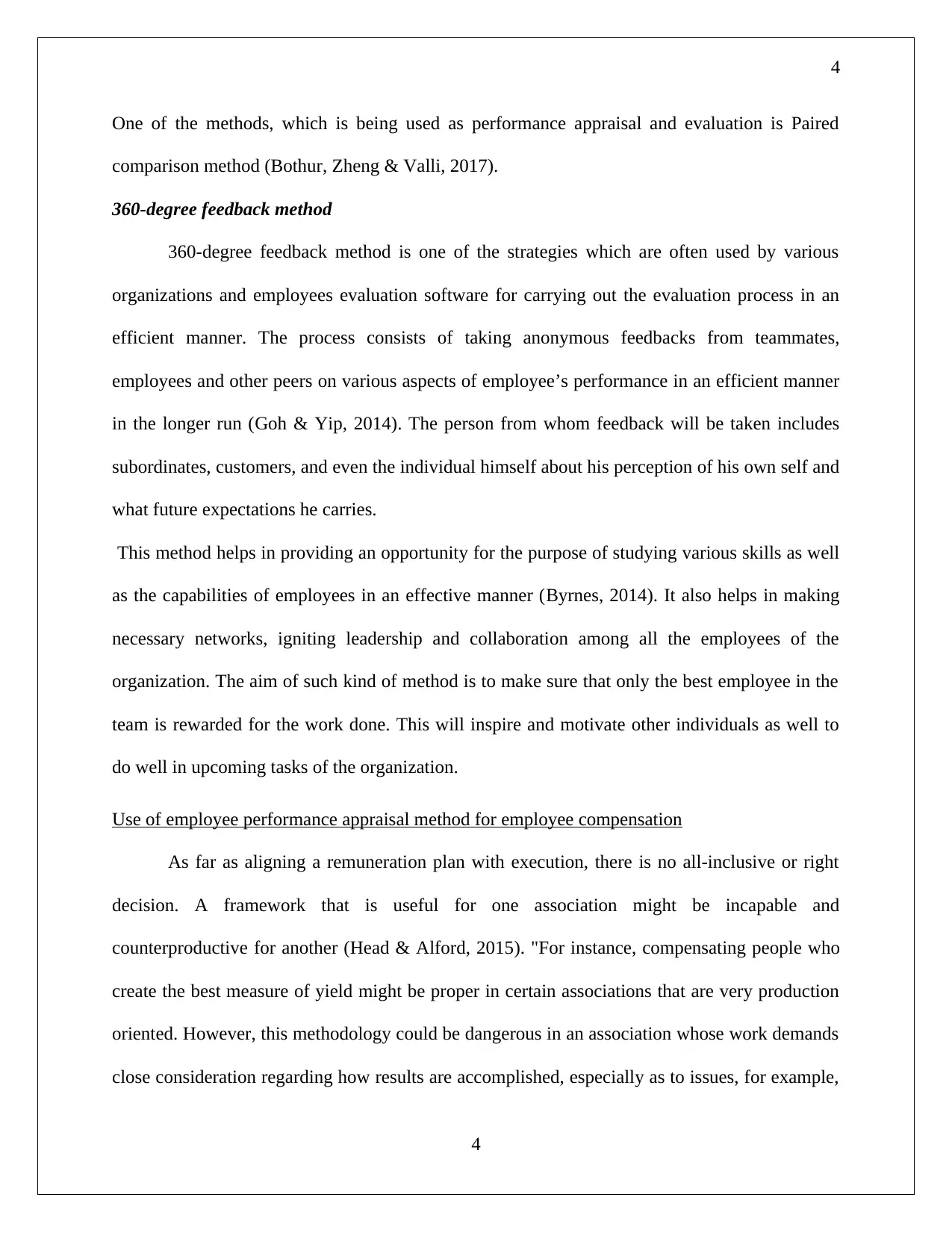
4
One of the methods, which is being used as performance appraisal and evaluation is Paired
comparison method (Bothur, Zheng & Valli, 2017).
360-degree feedback method
360-degree feedback method is one of the strategies which are often used by various
organizations and employees evaluation software for carrying out the evaluation process in an
efficient manner. The process consists of taking anonymous feedbacks from teammates,
employees and other peers on various aspects of employee’s performance in an efficient manner
in the longer run (Goh & Yip, 2014). The person from whom feedback will be taken includes
subordinates, customers, and even the individual himself about his perception of his own self and
what future expectations he carries.
This method helps in providing an opportunity for the purpose of studying various skills as well
as the capabilities of employees in an effective manner (Byrnes, 2014). It also helps in making
necessary networks, igniting leadership and collaboration among all the employees of the
organization. The aim of such kind of method is to make sure that only the best employee in the
team is rewarded for the work done. This will inspire and motivate other individuals as well to
do well in upcoming tasks of the organization.
Use of employee performance appraisal method for employee compensation
As far as aligning a remuneration plan with execution, there is no all-inclusive or right
decision. A framework that is useful for one association might be incapable and
counterproductive for another (Head & Alford, 2015). "For instance, compensating people who
create the best measure of yield might be proper in certain associations that are very production
oriented. However, this methodology could be dangerous in an association whose work demands
close consideration regarding how results are accomplished, especially as to issues, for example,
4
One of the methods, which is being used as performance appraisal and evaluation is Paired
comparison method (Bothur, Zheng & Valli, 2017).
360-degree feedback method
360-degree feedback method is one of the strategies which are often used by various
organizations and employees evaluation software for carrying out the evaluation process in an
efficient manner. The process consists of taking anonymous feedbacks from teammates,
employees and other peers on various aspects of employee’s performance in an efficient manner
in the longer run (Goh & Yip, 2014). The person from whom feedback will be taken includes
subordinates, customers, and even the individual himself about his perception of his own self and
what future expectations he carries.
This method helps in providing an opportunity for the purpose of studying various skills as well
as the capabilities of employees in an effective manner (Byrnes, 2014). It also helps in making
necessary networks, igniting leadership and collaboration among all the employees of the
organization. The aim of such kind of method is to make sure that only the best employee in the
team is rewarded for the work done. This will inspire and motivate other individuals as well to
do well in upcoming tasks of the organization.
Use of employee performance appraisal method for employee compensation
As far as aligning a remuneration plan with execution, there is no all-inclusive or right
decision. A framework that is useful for one association might be incapable and
counterproductive for another (Head & Alford, 2015). "For instance, compensating people who
create the best measure of yield might be proper in certain associations that are very production
oriented. However, this methodology could be dangerous in an association whose work demands
close consideration regarding how results are accomplished, especially as to issues, for example,
4
Paraphrase This Document
Need a fresh take? Get an instant paraphrase of this document with our AI Paraphraser
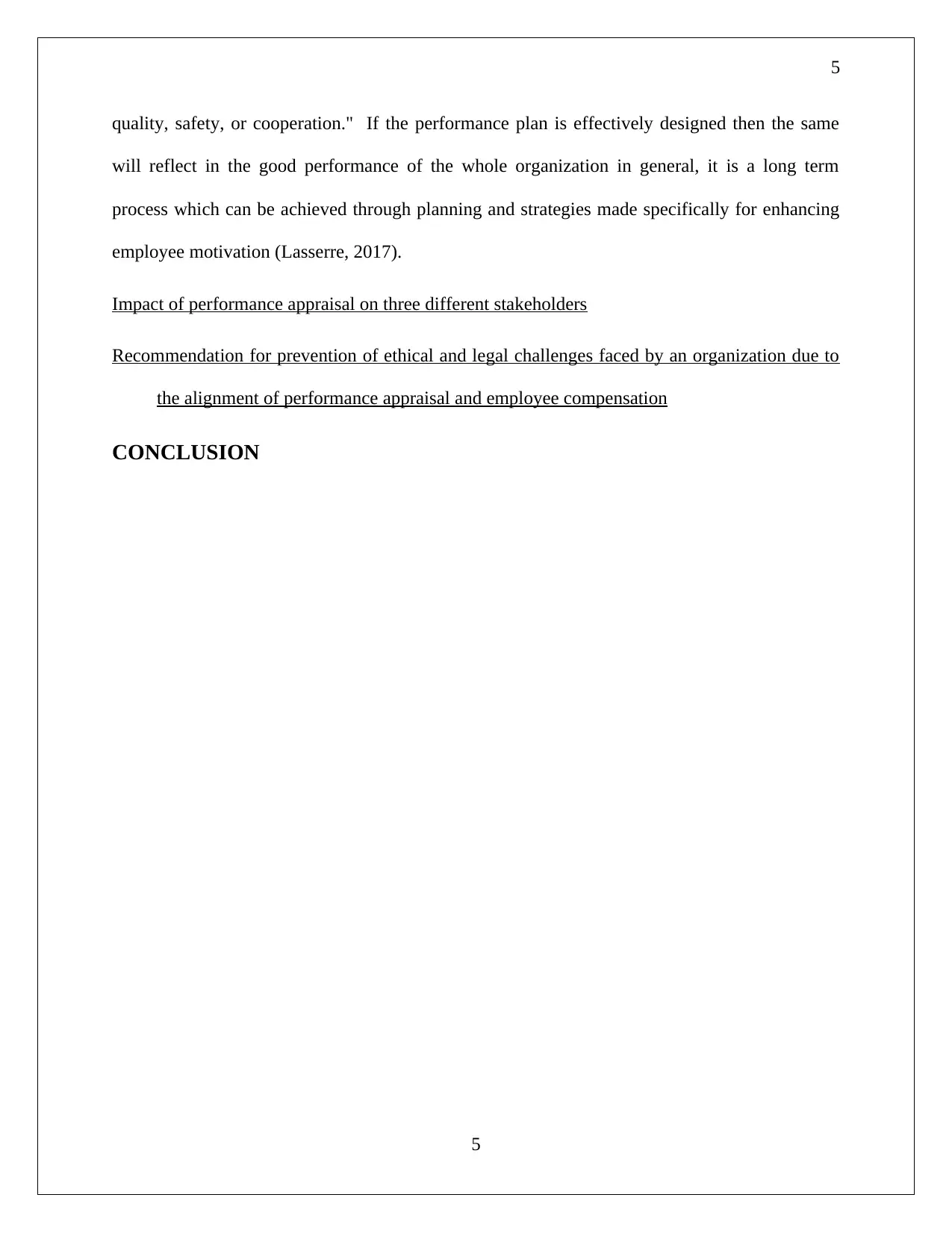
5
quality, safety, or cooperation." If the performance plan is effectively designed then the same
will reflect in the good performance of the whole organization in general, it is a long term
process which can be achieved through planning and strategies made specifically for enhancing
employee motivation (Lasserre, 2017).
Impact of performance appraisal on three different stakeholders
Recommendation for prevention of ethical and legal challenges faced by an organization due to
the alignment of performance appraisal and employee compensation
CONCLUSION
5
quality, safety, or cooperation." If the performance plan is effectively designed then the same
will reflect in the good performance of the whole organization in general, it is a long term
process which can be achieved through planning and strategies made specifically for enhancing
employee motivation (Lasserre, 2017).
Impact of performance appraisal on three different stakeholders
Recommendation for prevention of ethical and legal challenges faced by an organization due to
the alignment of performance appraisal and employee compensation
CONCLUSION
5
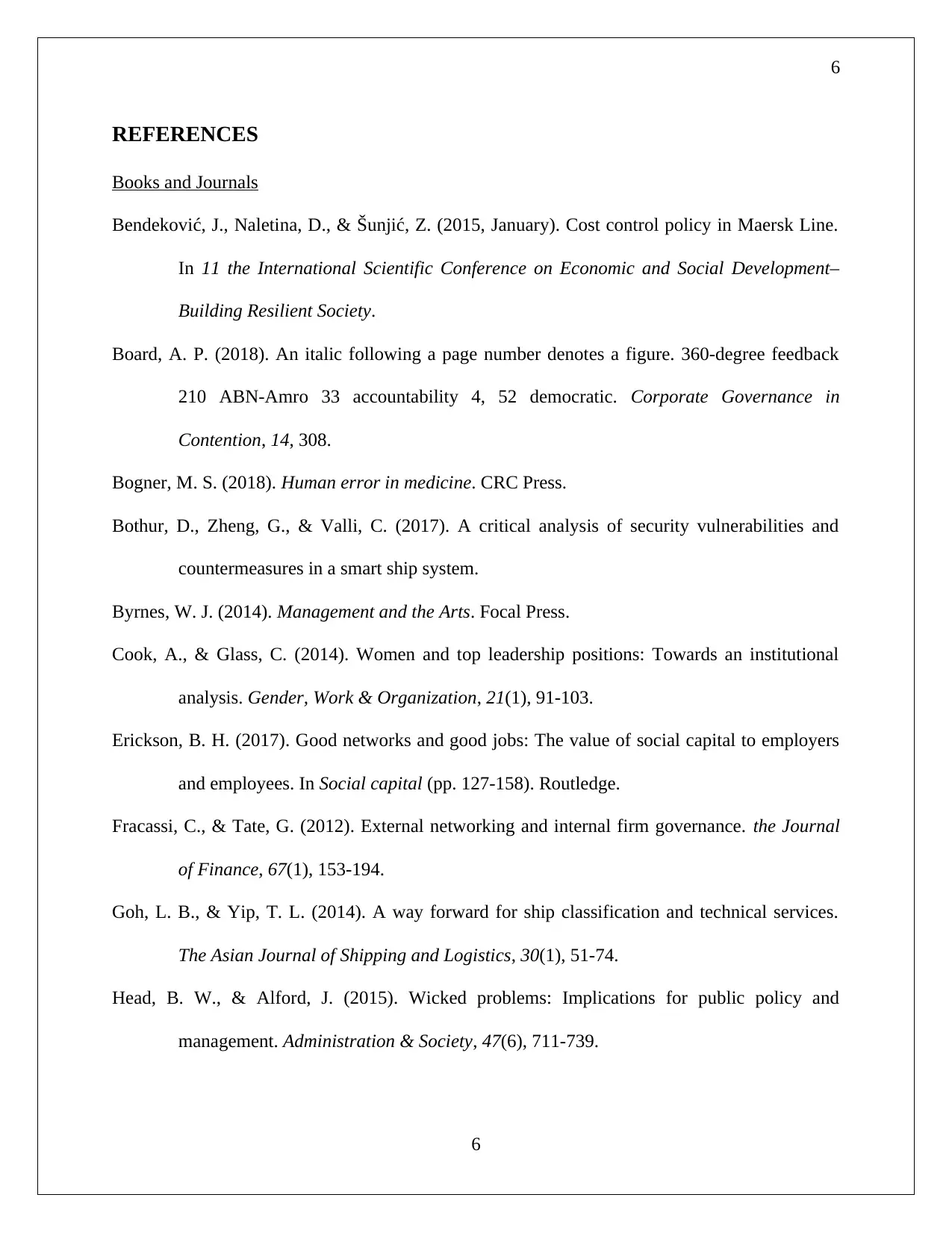
6
REFERENCES
Books and Journals
Bendeković, J., Naletina, D., & Šunjić, Z. (2015, January). Cost control policy in Maersk Line.
In 11 the International Scientific Conference on Economic and Social Development–
Building Resilient Society.
Board, A. P. (2018). An italic following a page number denotes a figure. 360-degree feedback
210 ABN-Amro 33 accountability 4, 52 democratic. Corporate Governance in
Contention, 14, 308.
Bogner, M. S. (2018). Human error in medicine. CRC Press.
Bothur, D., Zheng, G., & Valli, C. (2017). A critical analysis of security vulnerabilities and
countermeasures in a smart ship system.
Byrnes, W. J. (2014). Management and the Arts. Focal Press.
Cook, A., & Glass, C. (2014). Women and top leadership positions: Towards an institutional
analysis. Gender, Work & Organization, 21(1), 91-103.
Erickson, B. H. (2017). Good networks and good jobs: The value of social capital to employers
and employees. In Social capital (pp. 127-158). Routledge.
Fracassi, C., & Tate, G. (2012). External networking and internal firm governance. the Journal
of Finance, 67(1), 153-194.
Goh, L. B., & Yip, T. L. (2014). A way forward for ship classification and technical services.
The Asian Journal of Shipping and Logistics, 30(1), 51-74.
Head, B. W., & Alford, J. (2015). Wicked problems: Implications for public policy and
management. Administration & Society, 47(6), 711-739.
6
REFERENCES
Books and Journals
Bendeković, J., Naletina, D., & Šunjić, Z. (2015, January). Cost control policy in Maersk Line.
In 11 the International Scientific Conference on Economic and Social Development–
Building Resilient Society.
Board, A. P. (2018). An italic following a page number denotes a figure. 360-degree feedback
210 ABN-Amro 33 accountability 4, 52 democratic. Corporate Governance in
Contention, 14, 308.
Bogner, M. S. (2018). Human error in medicine. CRC Press.
Bothur, D., Zheng, G., & Valli, C. (2017). A critical analysis of security vulnerabilities and
countermeasures in a smart ship system.
Byrnes, W. J. (2014). Management and the Arts. Focal Press.
Cook, A., & Glass, C. (2014). Women and top leadership positions: Towards an institutional
analysis. Gender, Work & Organization, 21(1), 91-103.
Erickson, B. H. (2017). Good networks and good jobs: The value of social capital to employers
and employees. In Social capital (pp. 127-158). Routledge.
Fracassi, C., & Tate, G. (2012). External networking and internal firm governance. the Journal
of Finance, 67(1), 153-194.
Goh, L. B., & Yip, T. L. (2014). A way forward for ship classification and technical services.
The Asian Journal of Shipping and Logistics, 30(1), 51-74.
Head, B. W., & Alford, J. (2015). Wicked problems: Implications for public policy and
management. Administration & Society, 47(6), 711-739.
6
⊘ This is a preview!⊘
Do you want full access?
Subscribe today to unlock all pages.

Trusted by 1+ million students worldwide
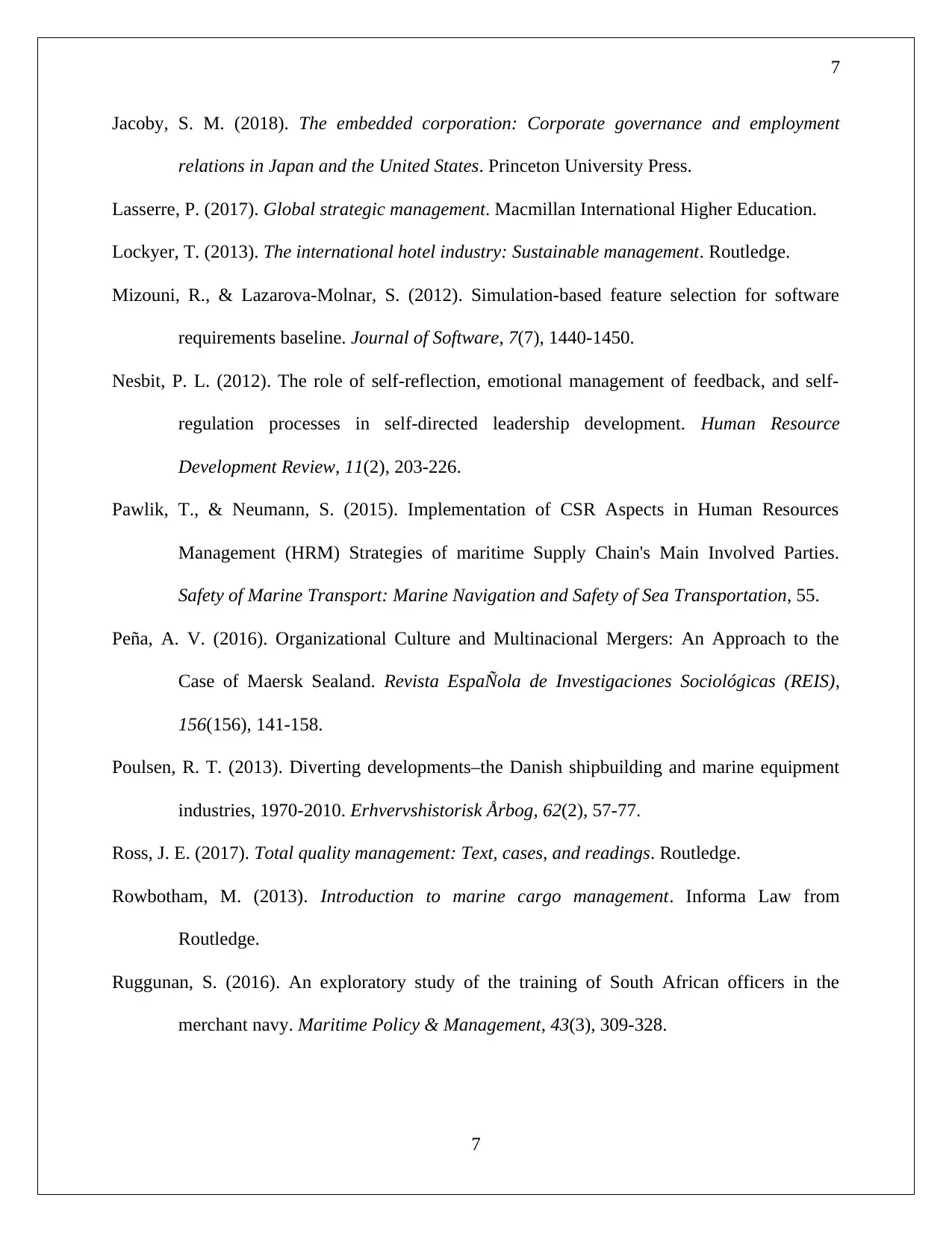
7
Jacoby, S. M. (2018). The embedded corporation: Corporate governance and employment
relations in Japan and the United States. Princeton University Press.
Lasserre, P. (2017). Global strategic management. Macmillan International Higher Education.
Lockyer, T. (2013). The international hotel industry: Sustainable management. Routledge.
Mizouni, R., & Lazarova-Molnar, S. (2012). Simulation-based feature selection for software
requirements baseline. Journal of Software, 7(7), 1440-1450.
Nesbit, P. L. (2012). The role of self-reflection, emotional management of feedback, and self-
regulation processes in self-directed leadership development. Human Resource
Development Review, 11(2), 203-226.
Pawlik, T., & Neumann, S. (2015). Implementation of CSR Aspects in Human Resources
Management (HRM) Strategies of maritime Supply Chain's Main Involved Parties.
Safety of Marine Transport: Marine Navigation and Safety of Sea Transportation, 55.
Peña, A. V. (2016). Organizational Culture and Multinacional Mergers: An Approach to the
Case of Maersk Sealand. Revista EspaÑola de Investigaciones Sociológicas (REIS),
156(156), 141-158.
Poulsen, R. T. (2013). Diverting developments–the Danish shipbuilding and marine equipment
industries, 1970-2010. Erhvervshistorisk Årbog, 62(2), 57-77.
Ross, J. E. (2017). Total quality management: Text, cases, and readings. Routledge.
Rowbotham, M. (2013). Introduction to marine cargo management. Informa Law from
Routledge.
Ruggunan, S. (2016). An exploratory study of the training of South African officers in the
merchant navy. Maritime Policy & Management, 43(3), 309-328.
7
Jacoby, S. M. (2018). The embedded corporation: Corporate governance and employment
relations in Japan and the United States. Princeton University Press.
Lasserre, P. (2017). Global strategic management. Macmillan International Higher Education.
Lockyer, T. (2013). The international hotel industry: Sustainable management. Routledge.
Mizouni, R., & Lazarova-Molnar, S. (2012). Simulation-based feature selection for software
requirements baseline. Journal of Software, 7(7), 1440-1450.
Nesbit, P. L. (2012). The role of self-reflection, emotional management of feedback, and self-
regulation processes in self-directed leadership development. Human Resource
Development Review, 11(2), 203-226.
Pawlik, T., & Neumann, S. (2015). Implementation of CSR Aspects in Human Resources
Management (HRM) Strategies of maritime Supply Chain's Main Involved Parties.
Safety of Marine Transport: Marine Navigation and Safety of Sea Transportation, 55.
Peña, A. V. (2016). Organizational Culture and Multinacional Mergers: An Approach to the
Case of Maersk Sealand. Revista EspaÑola de Investigaciones Sociológicas (REIS),
156(156), 141-158.
Poulsen, R. T. (2013). Diverting developments–the Danish shipbuilding and marine equipment
industries, 1970-2010. Erhvervshistorisk Årbog, 62(2), 57-77.
Ross, J. E. (2017). Total quality management: Text, cases, and readings. Routledge.
Rowbotham, M. (2013). Introduction to marine cargo management. Informa Law from
Routledge.
Ruggunan, S. (2016). An exploratory study of the training of South African officers in the
merchant navy. Maritime Policy & Management, 43(3), 309-328.
7
Paraphrase This Document
Need a fresh take? Get an instant paraphrase of this document with our AI Paraphraser
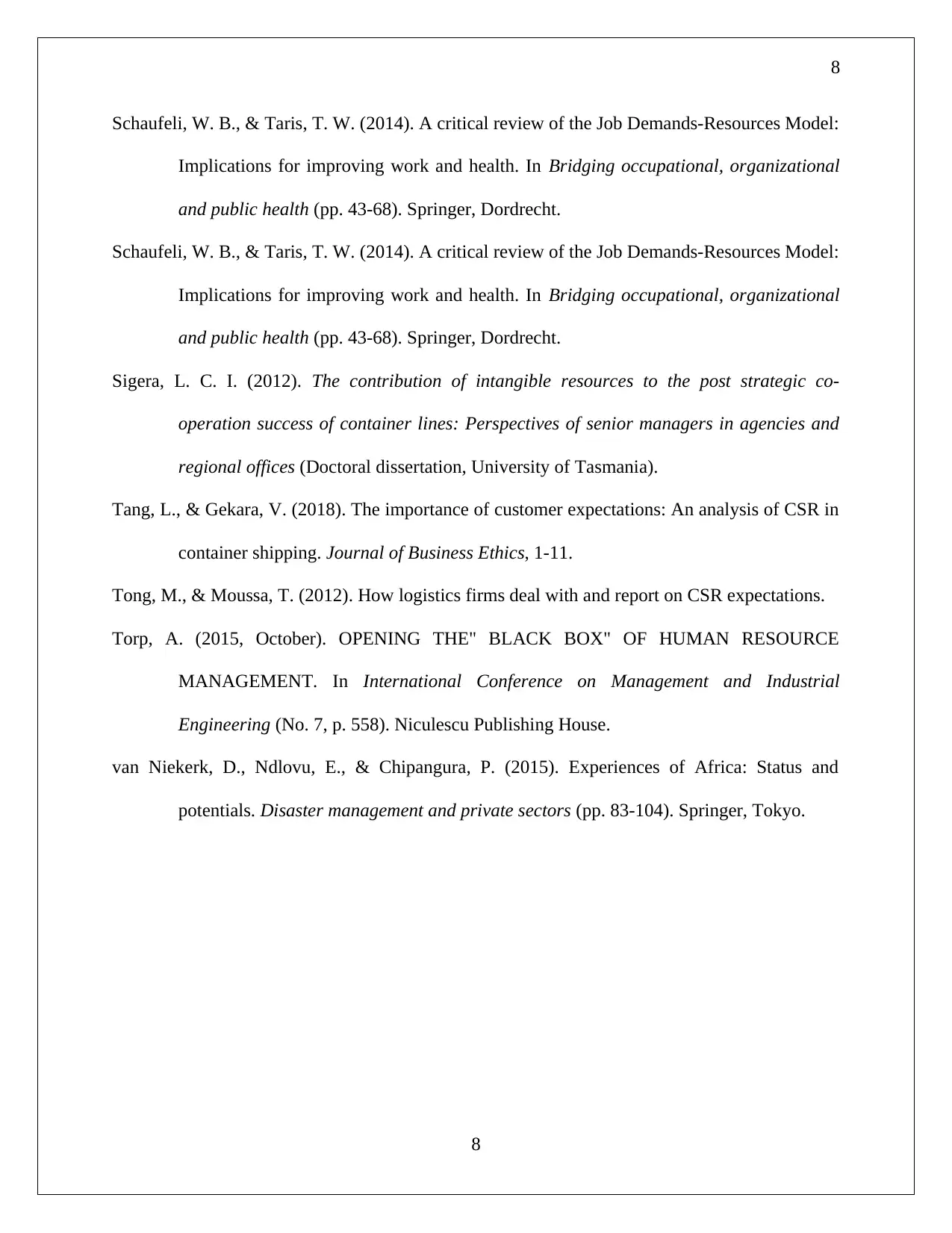
8
Schaufeli, W. B., & Taris, T. W. (2014). A critical review of the Job Demands-Resources Model:
Implications for improving work and health. In Bridging occupational, organizational
and public health (pp. 43-68). Springer, Dordrecht.
Schaufeli, W. B., & Taris, T. W. (2014). A critical review of the Job Demands-Resources Model:
Implications for improving work and health. In Bridging occupational, organizational
and public health (pp. 43-68). Springer, Dordrecht.
Sigera, L. C. I. (2012). The contribution of intangible resources to the post strategic co-
operation success of container lines: Perspectives of senior managers in agencies and
regional offices (Doctoral dissertation, University of Tasmania).
Tang, L., & Gekara, V. (2018). The importance of customer expectations: An analysis of CSR in
container shipping. Journal of Business Ethics, 1-11.
Tong, M., & Moussa, T. (2012). How logistics firms deal with and report on CSR expectations.
Torp, A. (2015, October). OPENING THE" BLACK BOX" OF HUMAN RESOURCE
MANAGEMENT. In International Conference on Management and Industrial
Engineering (No. 7, p. 558). Niculescu Publishing House.
van Niekerk, D., Ndlovu, E., & Chipangura, P. (2015). Experiences of Africa: Status and
potentials. Disaster management and private sectors (pp. 83-104). Springer, Tokyo.
8
Schaufeli, W. B., & Taris, T. W. (2014). A critical review of the Job Demands-Resources Model:
Implications for improving work and health. In Bridging occupational, organizational
and public health (pp. 43-68). Springer, Dordrecht.
Schaufeli, W. B., & Taris, T. W. (2014). A critical review of the Job Demands-Resources Model:
Implications for improving work and health. In Bridging occupational, organizational
and public health (pp. 43-68). Springer, Dordrecht.
Sigera, L. C. I. (2012). The contribution of intangible resources to the post strategic co-
operation success of container lines: Perspectives of senior managers in agencies and
regional offices (Doctoral dissertation, University of Tasmania).
Tang, L., & Gekara, V. (2018). The importance of customer expectations: An analysis of CSR in
container shipping. Journal of Business Ethics, 1-11.
Tong, M., & Moussa, T. (2012). How logistics firms deal with and report on CSR expectations.
Torp, A. (2015, October). OPENING THE" BLACK BOX" OF HUMAN RESOURCE
MANAGEMENT. In International Conference on Management and Industrial
Engineering (No. 7, p. 558). Niculescu Publishing House.
van Niekerk, D., Ndlovu, E., & Chipangura, P. (2015). Experiences of Africa: Status and
potentials. Disaster management and private sectors (pp. 83-104). Springer, Tokyo.
8
1 out of 8
Related Documents
Your All-in-One AI-Powered Toolkit for Academic Success.
+13062052269
info@desklib.com
Available 24*7 on WhatsApp / Email
![[object Object]](/_next/static/media/star-bottom.7253800d.svg)
Unlock your academic potential
Copyright © 2020–2025 A2Z Services. All Rights Reserved. Developed and managed by ZUCOL.





